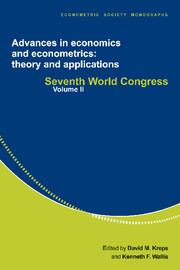Book contents
- Frontmatter
- 1 Incentives and careers in organizations
- 2 Endogenous growth: lessons for and from economic history
- 3 Microtheory and recent developments in the study of economic institutions through economic history
- 4 Poverty traps
- 5 Microenterprise and macropolicy
- 6 Markets in transition
- 7 Transition as a process of large-scale institutional change
- 8 A Schumpeterian perspective on growth and competition
- 9 Learning and growth
- Index
3 - Microtheory and recent developments in the study of economic institutions through economic history
Published online by Cambridge University Press: 05 January 2013
- Frontmatter
- 1 Incentives and careers in organizations
- 2 Endogenous growth: lessons for and from economic history
- 3 Microtheory and recent developments in the study of economic institutions through economic history
- 4 Poverty traps
- 5 Microenterprise and macropolicy
- 6 Markets in transition
- 7 Transition as a process of large-scale institutional change
- 8 A Schumpeterian perspective on growth and competition
- 9 Learning and growth
- Index
Summary
INTRODUCTION
Adam Smith ([1776] 1937) argued that the “propensity to truck, barter, and exchange” is in human nature (p. 13) and proceeded to examine how institutions impact the efficiency implications of this tendency. Arguably, institutions impact efficiency since they influence the allocation of resources to and by economic agents and the set of exchange relations that these agents are willing to assume. The diversity of economic environments and institutions utilized throughout history provides a unique source for examining the nature and implications of institutions. Indeed, a distinctive feature of economic history has always been its concentration on the examination of institutions, their origins, natures, and implications.
This chapter provides a brief survey of the three approaches within economic history - the neoclassical (section 1), the new institutional economic history (section 2), and the historical institutional analysis (section 3) - that utilize microeconomic theory for the study of institutions and their efficiency implications. Each of these complementary approaches focuses on different sets of institutions, utilizes different theoretical frameworks to analyze them, and advances different methodologies to integrate theoretical and historical analyses.
Owing to space limitation this chapter concentrates on highlighting the methodology of and interrelations with microeconomic theory adopted by these approaches, and gives some of their insights with respect the study of economic institutions. Since historical analysis is the most recent development in the study of economic institutions through economic history, most of the survey is devoted to this approach.
- Type
- Chapter
- Information
- Advances in Economics and Econometrics: Theory and ApplicationsSeventh World Congress, pp. 79 - 113Publisher: Cambridge University PressPrint publication year: 1997
- 18
- Cited by

